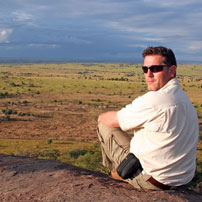 Having travelled the length and breadth of the Serengeti (Tanzania) on two occasions during this year, and spent time touring the private conservancies of the Masai Mara (Kenya), I thought it would be interesting to compare these two iconic safari regions. They are of the same major grassland ecosystem and home of the greatest migration of land mammals on earth.
Having travelled the length and breadth of the Serengeti (Tanzania) on two occasions during this year, and spent time touring the private conservancies of the Masai Mara (Kenya), I thought it would be interesting to compare these two iconic safari regions. They are of the same major grassland ecosystem and home of the greatest migration of land mammals on earth.
There is an argument that the scenery of these great areas is ‘open grassland’ and there is little more to say. If compared to mountains, desert or jungle then yes, both the Serengeti and Masai Mara would be described as savannah grassland. However, looking more closely you notice there is huge variation in terrain, scenery and habitat.
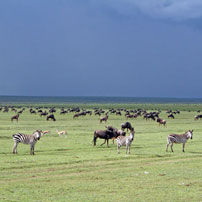 The largest, flattest, most never-ending short grass plains are found in the southern Serengeti, extending into what is known as the Ngorongoro Crater Conservation Area. It is on these plains that the great herds of wildebeest gather and then calve between December and March, a time of year where they can find water as well as bountiful fresh grazing created by the short rainy season in November/ December.
The largest, flattest, most never-ending short grass plains are found in the southern Serengeti, extending into what is known as the Ngorongoro Crater Conservation Area. It is on these plains that the great herds of wildebeest gather and then calve between December and March, a time of year where they can find water as well as bountiful fresh grazing created by the short rainy season in November/ December.
Moving slightly north, there are some staggeringly beautiful ‘sweeping’ plains in the central and eastern Serengeti. These are predominantly long grass plains which are intersected by river courses and dotted with rocky outcrops, known as ‘kopjes’ which surely gave inspiration to ‘Pride Rock’ in the Lion King. To me, 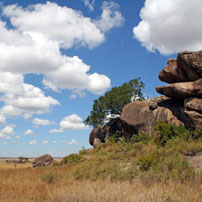 these areas are absolutely typical ‘Serengeti’, offering an overwhelming feeling of space and beauty.
these areas are absolutely typical ‘Serengeti’, offering an overwhelming feeling of space and beauty.
The western and northern Serengeti tends to be more hilly offering a different landscape. There is also significantly more woodland, though you are never far from wide open plains as illustrate quite clearly in the stunning Wogakuria Hills of the northern Serengeti. At the foot of these hills the Mara River cuts across the north-western sector of the National Park and provides the location for many of the best ‘river crossings’ you are likely to witness.
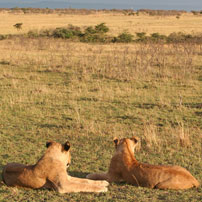 Across the border in Kenya, the Masai Mara’s most sweeping open plains are found in the official Masai Mara Reserve, including the ‘Mara Triangle’ (the land found to the west of the Mara River as it cuts its path southwards through the reserve). With the impressive Siria Escarpment as a back drop, the Masai Mara is picture perfect. The Mara River is flanked by dense forest, a snaking swathe of green through an otherwise open and often ‘yellow’ landscape. As you move north out of the official reserve, into the more exclusive private conservancies (private Maasai land that is given over to tourism and conservation with significant proceeds heading back to the local communities), the terrain becomes more varied, with multiple river courses, drainage lines, rocky escarpments and plateaus, hidden valleys and acacia woodland. The scenery can vary from one moment to the next, from the open Aitong Plains to the aptly named ‘Leopard Gorge’.
Across the border in Kenya, the Masai Mara’s most sweeping open plains are found in the official Masai Mara Reserve, including the ‘Mara Triangle’ (the land found to the west of the Mara River as it cuts its path southwards through the reserve). With the impressive Siria Escarpment as a back drop, the Masai Mara is picture perfect. The Mara River is flanked by dense forest, a snaking swathe of green through an otherwise open and often ‘yellow’ landscape. As you move north out of the official reserve, into the more exclusive private conservancies (private Maasai land that is given over to tourism and conservation with significant proceeds heading back to the local communities), the terrain becomes more varied, with multiple river courses, drainage lines, rocky escarpments and plateaus, hidden valleys and acacia woodland. The scenery can vary from one moment to the next, from the open Aitong Plains to the aptly named ‘Leopard Gorge’.
The common theme through all these habitats is the abundance of wildlife. There is nowhere on earth that can boast of such riches when it comes to land mammals. The vast grassland ecosystem supports huge numbers of herbivores – Thomson’s gazelle, zebra and wildebeest make up the great migration but there are also large numbers of giraffe, elephant, buffalo, eland, topi, hartebeest, hippo, Grant’s gazelle, impala and many other species. Where you have prey, you will surely find predators, and they are found in relative abundance – lions, leopards, cheetahs, hyaena, wild dogs and not forgetting the merciless crocodiles.
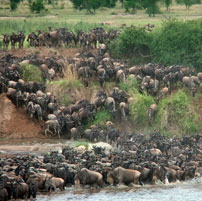 So, is one region better than the other for game-viewing? This is possibly one of the hardest questions to answer. In short, I can’t see that I could claim that one part of this incredible ecosystem is noticeably more productive than the other, but there are differences.
So, is one region better than the other for game-viewing? This is possibly one of the hardest questions to answer. In short, I can’t see that I could claim that one part of this incredible ecosystem is noticeably more productive than the other, but there are differences.
The Serengeti is fundamentally bigger, and there are sections of the Serengeti where game concentrations are not as high as others, or most of the Masai Mara. I think this is especially true in the northern and eastern Serengeti with the exception of the immediate Mara River region.
The Serengeti is also more seasonal, with certain areas changing quite dramatically throughout the year. For instance the southern Serengeti region suffers from a lack of grazing and fresh water during the dry season (especially July to October), and becomes a much drier, harsher environment with much less game around than you would experience during the green season (December to May).
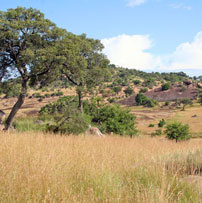 In contrast, whilst the Masai Mara also changes throughout the year, and there is a distinct ‘migration season’ (July to October), there is a lot more resident game which does not migrate. Although the Mara does, from time to time, experience severe drought but in general it can rain at almost any time of year and that is of course partly responsible for the wonderful conditions.
In contrast, whilst the Masai Mara also changes throughout the year, and there is a distinct ‘migration season’ (July to October), there is a lot more resident game which does not migrate. Although the Mara does, from time to time, experience severe drought but in general it can rain at almost any time of year and that is of course partly responsible for the wonderful conditions.
In terms of what you might actually see and experience, it is also worth considering park regulations and available activities. In much of the Serengeti National Park and inside the official Masai Mara Game Reserve, you are almost entirely limited to game drives by day, sticking to the well traversed road network (there are very few areas in the Serengeti ecosystem where walking or night drives are permitted). However, if you visit the Mara private conservancies, you will find that walking, night drives and off road driving are permitted (though not offered at all camps), all of which can enhance your game-viewing experience.
For viewing the migration herds, it simply comes down to timing – you can visit the Serengeti all year round (December to April in the south; May to early July in the central/west; late July to November in the north). With the Masai Mara, you need to travel from late July through to late October.
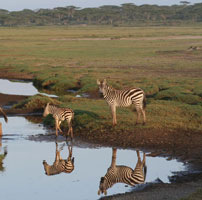 River crossings can be viewed between July and November, principally on the Mara River in either the Serengeti (Tanzania) or the Masai Mara (Kenya) but also along some minor rivers such as the Grumeti (Serengeti) and Talek (Mara). Whilst Kenya’s Masai Mara has traditionally been the most guaranteed venue to hang out for these (especially August/ September), increasingly the northern Serengeti is stealing the limelight – there are about 10 different crossing points along the Mara River in the northern Serengeti.
River crossings can be viewed between July and November, principally on the Mara River in either the Serengeti (Tanzania) or the Masai Mara (Kenya) but also along some minor rivers such as the Grumeti (Serengeti) and Talek (Mara). Whilst Kenya’s Masai Mara has traditionally been the most guaranteed venue to hang out for these (especially August/ September), increasingly the northern Serengeti is stealing the limelight – there are about 10 different crossing points along the Mara River in the northern Serengeti.
For the predators, both areas are amazing although in terms of the density of lion, I would say the Masai Mara just has the advantage. Cheetah thrive better in the open grassland space afforded by the Serengeti, perhaps because lions are marginally less of a threat.
However, the most relevant factor to consider regarding game-viewing is the potential exclusivity and flexibility available in the Mara Conservancies. Finding a leopard in the central Serengeti region or a cheetah on the southern Serengeti plains is more likely to result in the sighting of a lot of other tourist vehicles. The same is true of the official Masai Mara Game Reserve. However, in the Mara Conservancies, local regulations limit the number of vehicles at sightings and you’re more likely to spend time alone with the big cats. To many people this alone is a huge factor.
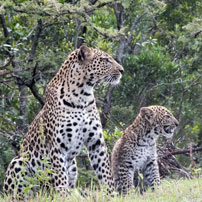 On balance, it is important to be specific in ‘where you go when in the Serengeti’ which may result in your covering a lot more ground in your search for wildlife. The Masai Mara offers a slightly more ‘condensed’ game-viewing arena, and pound for pound, perhaps throws a slightly harder punch. However, both regions have their own magic, and ultimately, both should be experienced. It used to be that separate trips were recommended to experience both countries, but the increased number of flight options in the last few years has made it possible to combine the two (the most recent inclusion is a direct link between Kenya’s Nairobi and the Serengeti in Tanzania).
On balance, it is important to be specific in ‘where you go when in the Serengeti’ which may result in your covering a lot more ground in your search for wildlife. The Masai Mara offers a slightly more ‘condensed’ game-viewing arena, and pound for pound, perhaps throws a slightly harder punch. However, both regions have their own magic, and ultimately, both should be experienced. It used to be that separate trips were recommended to experience both countries, but the increased number of flight options in the last few years has made it possible to combine the two (the most recent inclusion is a direct link between Kenya’s Nairobi and the Serengeti in Tanzania).
Having spent a fair amount of time exploring these fabulous regions, my best advice is that people could spend much longer than they usually do exploring this ecosystem. Quick 3 or 4 night safaris to either the Serengeti to the Masai can be perfect, especially where time constraints or budget dictates, but for anyone with the time and inclination, 7 to 10 nights would perhaps do the region better justice.
Please click on the following links to see video footage as follows:
Predators of the Serengeti/Mara
Leopard Magic in the Mara North Conservancy
Rob and Fran journey through the central and northern Serengeti and Masai Mara

